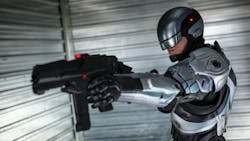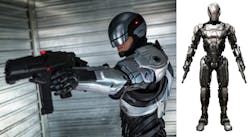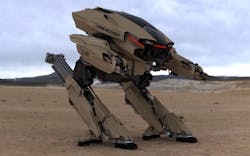RoboCopgets a reboot in 2014 with the new film directed by José Padilha and starring Joel Kinnaman as Alex Murphy, the man inside the machine (Fig. 1). For those who missed the 1987 iteration starring Peter Weller, Alex Murphy is a policeman who is murdered and then revived by Omni Consumer Products (OCP), a rather malevolent mega-corporation. I’ve seen the original many times and look forward to the remake, set in 2028, because there are a few things I want to check out after talking with Martin Whist and Jamie Price.
Moving Closer To Reality
As production designer, Whist was responsible for the overall feel of the movie. He has a long track record including films like the sci-fi hit Super 8 directed by J.J. Abrams. He and his colleagues did a good bit of research into what is now on the drawing board for everything from super soldiers and police to what might be in the kitchen in 2028. (Just check out the refrigerator in the movie.)
The challenge was to deliver something that was not only slick and compelling but also realistic since 2028 is right around the corner. Of course, this is a movie and presentation sometimes trumps realism. But the technology generally is on track, so engineers can enjoy the film even when they’re viewing it with a technically critical eye. For example, graphene-based armor is being considered now because of its strength and light weight. There are production challenges when working with graphene, but they may be overcome by 2028.
Computer interfaces from 3D gesture recognition to transparent heads-up displays (HUDs) are in the mix as well in the new RoboCop, but they’re most well known from films such as Minority Report and I, Robot. They are also in use now. At the 2014 International CES, Intel announced its RealSense including new 3D camera technology and an updated Perceptual Computing SDK (see “Interview: Barry Solomon Discusses Intel’s Perceptual Computing SDK” at electronicdesign.com). HUDs are creeping into high-end 2014 automobiles as well.
Martin’s job isn’t easy since he must tie in all aspects of the environment, from motorcycles to kitchens, as well as monstrosities like a large robot that had to be virtualized.
RoboCop Virtualization
Price was the VFX director for RoboCop. He led a team that turned Martin’s and José’s vision into the final film. This took a little bit of work when it came to the robots.
The ED-209 is a large robot in the film, so it was completely done using computer generated imagery (CGI) when it was moving (Fig. 2). The challenge was in creating an “eerieness” that combines familiar human proportions and movement while retaining the sense of massiveness. The robots have a more convincing gait so they don’t appear like they would just fall over.
The producers created an aluminum bar as a stand-in for the ED-209 so the actors had something to look at. Animation replaced the bar in the final cut. VFX techniques have improved significantly, so the director was not as limited by the production technology (see “Prometheus Takes Flight With Cutting-Edge VFX Technology” at electronicdesign.com).
The EM-208 robot was created using a spectrum of visual effect techniques. It always started with Kinnaman, but almost every shot has some augmentation of the suit. Typically, these additions to the shots included moving robotic parts or negative space in the joints. These enhancements are more akin to the robots we have today versus the space needed for a human elbow. Of course, implementing the action scenes required a bit of creativity too.
I’m looking forward to seeing RoboCop when it arrives in a theater nearby, and I will be taking a closer look at the environment as well as the robots and cyborgs running through it.
About the Author
William G. Wong
Senior Content Director - Electronic Design and Microwaves & RF
I am Editor of Electronic Design focusing on embedded, software, and systems. As Senior Content Director, I also manage Microwaves & RF and I work with a great team of editors to provide engineers, programmers, developers and technical managers with interesting and useful articles and videos on a regular basis. Check out our free newsletters to see the latest content.
You can send press releases for new products for possible coverage on the website. I am also interested in receiving contributed articles for publishing on our website. Use our template and send to me along with a signed release form.
Check out my blog, AltEmbedded on Electronic Design, as well as his latest articles on this site that are listed below.
You can visit my social media via these links:
- AltEmbedded on Electronic Design
- Bill Wong on Facebook
- @AltEmbedded on Twitter
- Bill Wong on LinkedIn
I earned a Bachelor of Electrical Engineering at the Georgia Institute of Technology and a Masters in Computer Science from Rutgers University. I still do a bit of programming using everything from C and C++ to Rust and Ada/SPARK. I do a bit of PHP programming for Drupal websites. I have posted a few Drupal modules.
I still get a hand on software and electronic hardware. Some of this can be found on our Kit Close-Up video series. You can also see me on many of our TechXchange Talk videos. I am interested in a range of projects from robotics to artificial intelligence.



